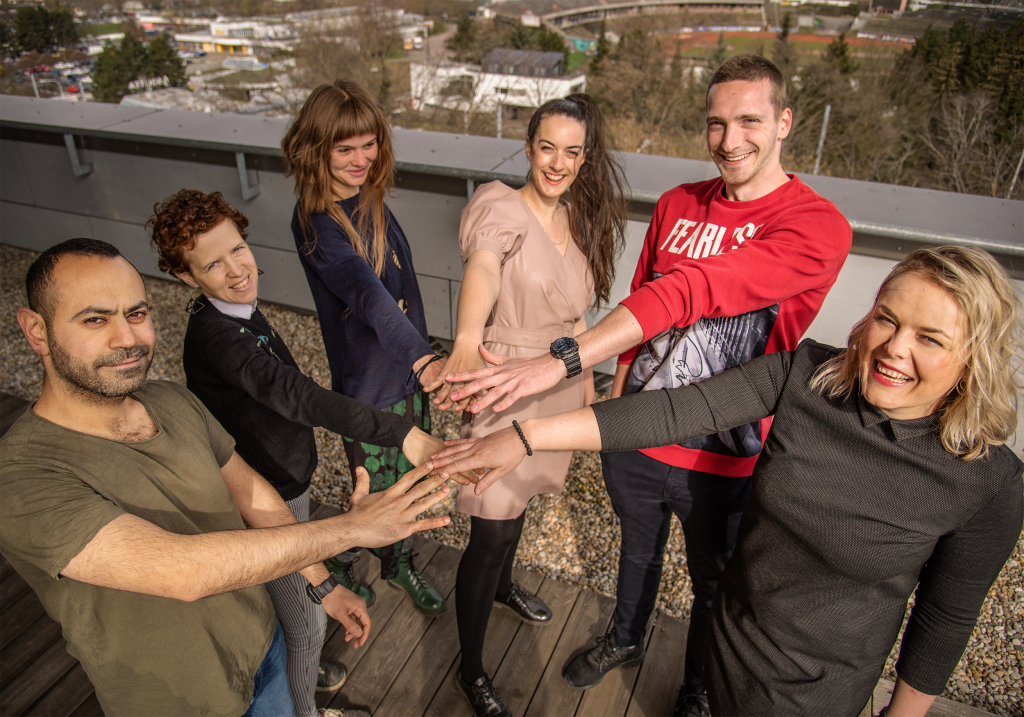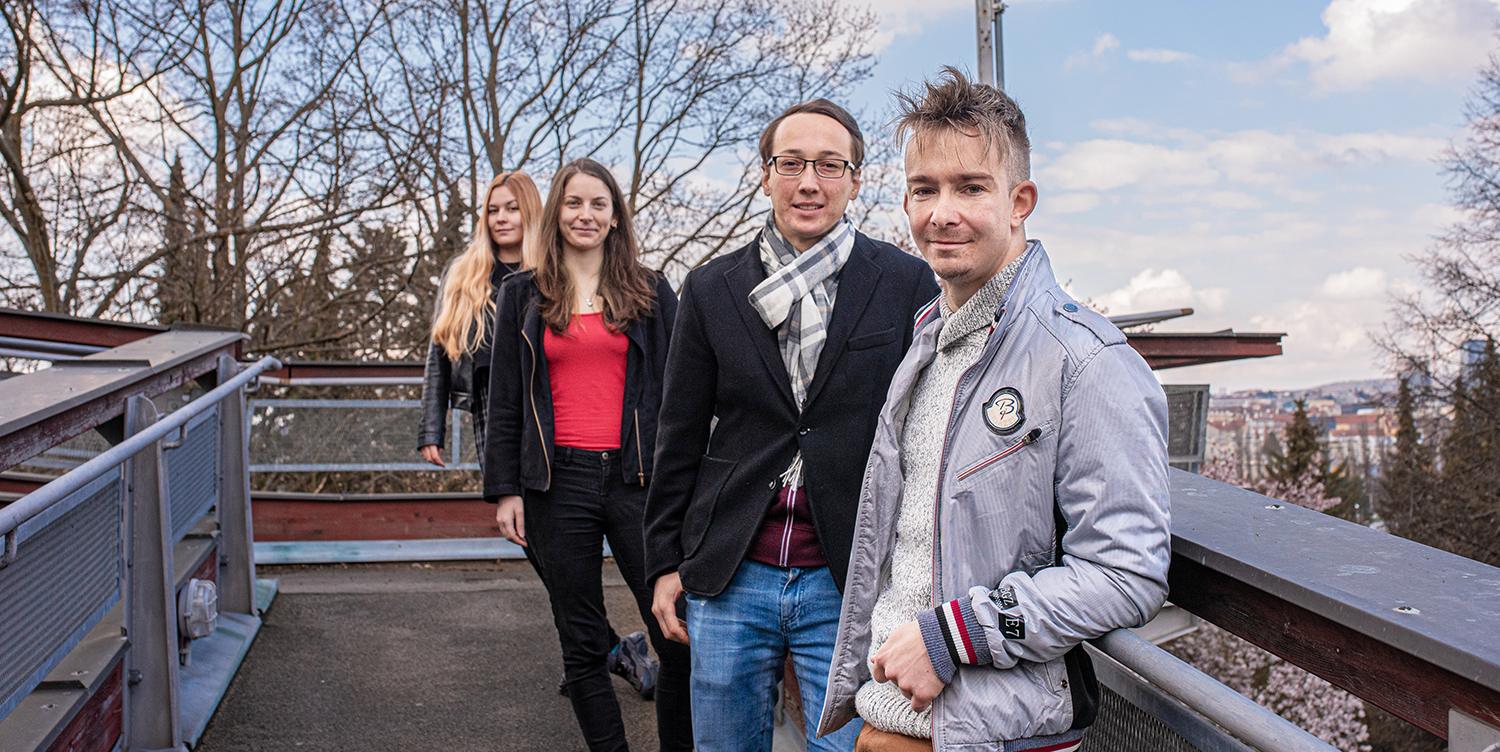
This year, Mendel University in Brno announced for the first time the Student Grant Competition “Igráček“, the primary goal of this grant is to increase the quality of teaching connected with research within doctoral studies with two years of financial support for projects. The solver of the student grant is not only the student of the doctoral study program, but also his team, which also includes mentors from the ranks of academic staff. This is a very prestigious grant, in which the winners will have a funded 10-day internship abroad and will also receive a financial award. Mendel University has announced a total of 4 winning teams and two of them are working at the Department of Chemistry and Biochemistry.One of the winners was the team of Martin Říháček from the laboratory of microbiology and the team of Ondřej Pěnčík from the laboratory of microalgae.
Martin Říháček
You participated with your team in the first year of the „Igráček“ Student Grant Competition, with what topic did you go to it?
Our work is called Multi-omics approach to study effects of agriculturally-used zinc on Escherichia coli: Risks assessment of bacterial resistance evolution, whose mentor is our leader, Ing. Kristýna Doleželíková, Ph.D. This is a work in which we will simulate the repeated load on the bacterium Escherichia coli using agriculturally used zinc (zinc oxide and its nanoparticle alternative). This is encountered in common agricultural practice in the nutrition of piglets, where zinc oxide is used as a prophylactic drug to prevent the development and spread of diarrhea among weaned piglets. Some strains of E. coli are the cause of these diarrhea. Other E. coli strains are beneficial, and repeated zinc loading can induce antibiotic resistance and the spread of this resistance genes further into the environment and eventually to humans, which can have a very serious impact on human health and medicine. At the same time, we will observe how bacteria behave after zinc withdrawal to see if there are reversible changes in the bacterial cell at the molecular level.
Martin, you have been working on your projects for a long time under our Department, have you always directed your work like this?
At DCB, I started my bachelor’s thesis in the laboratory of microbiology, where I worked with fungi / molds, in which I found an increase in the expression of ligninolytic enzymes caused by the addition of copper using molecular methods. Then, in my engineering studies, I switched to working with bacteria, where I tried to overcome antibiotic resistance by encapsulating them in nanomaterials, which I enjoyed more, so I stayed with it. In addition, increasing bacterial resistance to antibiotics, for example, is a huge problem today, so it is good to address it.
Is your dissertation paper related to the topic of the Student Grant Competition?
My dissertation paper will deal with the use of bacterial cellulose as a carrier for various antimicrobial substances with use in the fight against resistant bacteria and also as a possible replacement for zinc used in livestock nutrition. The results obtained by this project will be an important support in understanding the mechanism of antibiotic resistance due to agricultural zinc. To eliminate zinc-induced antibiotic resistance in bacteria, I want to work on the development of a nanocellulosic carrier of alternative drugs, which will be significantly more gentle in terms of the emergence and spread of resistance.
What did you have to do for this competition?
The work follows up on the bachelor’s thesis of student Daniela Bábiková, who also participates in solving this problem in the laboratory, when it was found that repeated loading of bacteria with zinc causes resistance of bacteria to antibiotics. That’s how it all started. First, it was necessary to study a lot of literature on the use of zinc in agriculture as a feed supplement, the development of bacterial resistance to zinc and antibiotics, gene transfer resistance between bacteria, etc. It was great that everyone from the team was involved, and joint efforts and we put it together through joint efforts and teamwork.
When the whole team found out that you were one of the winners, what was your first reaction?
When we found out that we had acquired Igráček, we were very satisfied. We were rewarded with a huge cake, which we ate immediately. But we now have a lot of work to do, during which we will learn new methodologies and modern analyzes, which we are already looking forward to.
Ondřej Pěnčík
Another winner, Ondřej Pěnčík, who represents the microalgae laboratory with a project on nanoplastics and their effect on various organisms, al o commented on the competition.
Ondro, with what topic did you participate in the first year of the „Igráček“ Student Grant Competition?
I’ll probably start a bit in detail by briefly introducing our lab and what we’re doing. The Laboratory of Plant and Microalgae Nanobiotechnology is divided into three „legs“, in which nanomaterials in plants and microalgae, space agriculture and biotechnological use of algae and cyanobacteria are studied. The topic thus more or less offers itself, as the pollution of plastics, especially nanoplastics and microplastics, is beginning to be a serious global problem for which not all risk factors are still known and which has only increased in connection with pandemics (disposable bags, hygiene aids, etc.) ). What is already known today is that nanoplastics and microplastics can bind heavy metals, organic pollutants and, due to their hydrophobic nature, easily penetrate cells. It is also estimated that each person eats the equivalent of one plastic fire helmet each year. That’s quite enough. At Igráček, we decided to combine the topic of even smaller particles (ie nanoplasts) and their influence on terrestrial, freshwater and oceanic organisms. Among the model organisms will be maize and peas, from cyanobacteria they will be representatives of a very important ocean picolankton – the genera Synechococcus and Prochlorococcus, which are the primary producers of oxygen in the ocean.
Ondro, how did you find yourself at the DCB?
I studied and in fact I am still studying at MUNI in the field of Microbiology and Molecular Biology, which is basically the content of my doctorate here. I actually got to the Department by pure chance. I originally dealt with the metagenomics of Antarctic permafrost under the guidance of prof. Sedláček. However, the project did not work out and there was no room for another doctoral student. So I started looking for another topic that wouldn’t be so far away – I was looking for something with an emphasis on bacteria / biotechnology / CRISPR-Cas9 / enviro and I came across Dr. Húska’s research group at the Department of Chemistry and Biochemistry, which was doing something that was closer to bacteria than I originally thought. At the same time, it was something new. It didn´t take long and instead of polar bacteria I focus on tropical cyanobacteria.
Will you use the data obtained from the „Igráček“ in your dissertation paper in any way?
The topic of my diploma thesis is CRISPR and cyanobacterial biotechnology. Specifically, it is about the development of a “smart” editing system for cyanobacteria, because the problem with cyanobacteria is that the expression of Cas9 /Cas12 nucleases is toxic to cells. Other programmable nucleases are already “obsolete” and difficult to design (TALEN, meganucleases, zinc-fingers). Since cyanobacteria are often referred to in connection with food for astronauts, biotechnological production of interesting substances, or even more often – as a source of hydrogen and other renewable fuels – it is annoying that there is no universal and non-toxic editing system for them. In addition, a number of genes in cyanobacteria are unexplored, mainly involving secondary metabolites (a possible source of biopharmaceuticals) and the assembly of thylakoids (a site where photosynthesis takes place that can be improved for better CO2 capture). Whether I will use this grant in any way to solve the diploma thesis? We can say I will, but only a small part – small in terms of the scope of the project. In addition, the articles will serve well as a proof of publishing activity.
What did this competition entail?
What did the competition entail? Well, because I can compare this with the Phd talent, which we attended with a colleague, this was much closer to a real grant application than Phd-talent. Due to the fact that multidisciplinarity is also evaluated here, cooperation with other workplaces had to be communicated. As we are the only ones at MENDELU in terms of cyanobacteria and microalgae, cooperation from „plants“ was logically offered. We have this cooperation with the CEITEC-MENDELU workplace and with the Institute of Agrochemistry, Soil Science, Microbiology and Plant Nutrition. But it was not so difficult to write the grant itself, but rather to make sure that everything was there and that it was understandable, because we had a limited scope. But yes, it was about 14-10 days of very intensive work and several meetings were arranged very quickly. The only thing that will probably be a big problém, is going to bet he orders – they are already incredibly late. And we are still waiting for the experimental organisms that are written in this grant. However, I firmly believe that we will manage the grant together and that it will be a valuable experience for all of us.
When you found out you were the winner, what was your reaction?
Well… (laughter) „Damn it“. But few minutes later „Great!“
Autor článku: Lenka Svobodová
Fotografie: Veronika Pavlačková
Překlad: Kateřina Richterová

